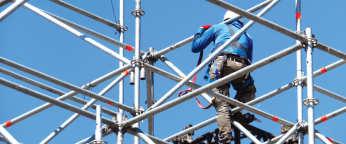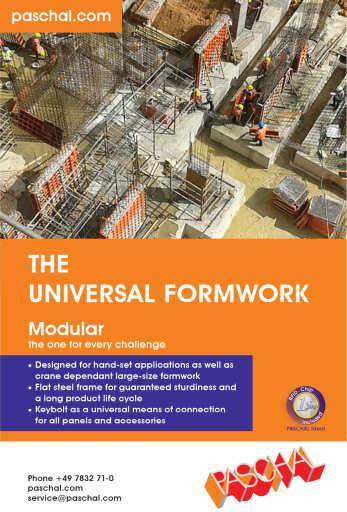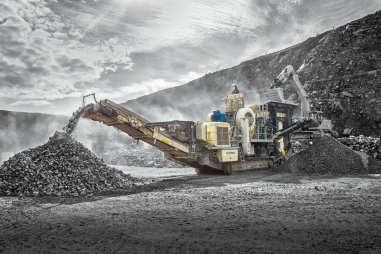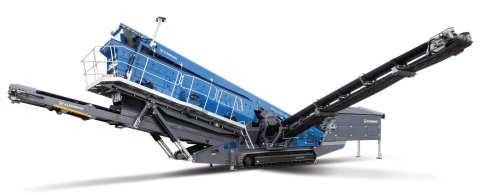
6 minute read
Formwork & Scaffolding
Things to know about dismantling scaffolding
The process of dismantling scaffolds remains a high-risk activity, not only to those carrying out the work, but to other workers and the general public.
IF WE'VE PROVEN anything by this point, it's that a properly erected scaffolding tower is an entirely safe structure. It's built to be a temporary array of metal and wooden elements, that's true enough, but that expertly constructed staging will remain stable for as long as it's required. What about after the completion of the work project? The scaffolding needs to come down in a safely controlled manner, right?
Defining dismantling dangers
A scaffolding contractor is responsible for removing the work platform, but there are no shortcuts available here, not when wooden planks and long metal tubes are suspended at a great height. Even if the project is finished and all of the workers have moved onto the next project, a poorly initiated dismantlement procedure will cause damage, both to the property and any lingering site workers. No, only systematic scaffolding dismantling methods can be allowed. With that said, where do we begin?
A systematic breakdown strategy
First of all, dismantlement work is every bit as hazardous as the erection process. A competent person must be on hand to oversee the process. Start by running a structural check. All components should still be firmly attached, which is to say none of the atheight work has caused parts to destablise on any of the levels of the structure. Wooden planks should be firmly seated and all fasteners must still be optimally anchored. Starting from the top, obviously, the ties and braces are dismantled. A minimally equipped fall prevention system is advised as the dismantling procedure continues. After all, the breakdown still involves a height hazard, so the fall prevention frame should remain until all other staging elements have been removed.
Returning the scaffolding to the ground
All of these safety points would seem to be obvious, but sometimes common sense takes a break. Never assume a prudential work ethic is on hand. Instead, assume the worst. In this case, the worst possible course of action would be to drop or throw the dismantled parts down to the ground. That's not an acceptable work procedure. Let's face it, that's not a process at all, not when the scaffolding requires a safe lowering mechanism. Its platforms and ropes, hoists and leveltolevel manpower lowering that properly gets those pieces back on the ground.
Before dismantling the scaffolding, remove all tools and construction materials from the wooden platforms. Also, disengage the support assemblies that bind the framework to a wall or window. Finally, and this should be another selfevident matter, don't conduct this potentially hazardous process if strong winds or a heavy storm is blowing overhead. ■
Source: C&N Scaffolding Hire

TEREX FINLAY HAS introduced LJ130 hybrid jaw crusher, which is the largest mobile jaw crusher in its range and has been developed for largescale quarry and mining operations. The machine can operate as standalone primary crusher or integrated into a mobile or static crushing and screening plant.
The machine incorporates a Terex 1300 x 1000mm (51” x 39”) high performance electrically driven single toggle jaw chamber. The large chamber inlet opening has been engineered to accept the coarsest feed including large boulders in the feed material and the chamber cavity depth of 2.3m (7' 5") provides high reduction ratios and maintains an efficient material flow through the plant.
The machine features a 13.5 cu/m (17.64yd³) hopper with an integrated pan feeder and heavy duty VGF feeder with automatic power monitoring to regulate and automatically increase or decrease material flow to prevent overload and ensure continuous choke feeding of the jaw chamber for optimum and uninterrupted productivity.
The machine can be powered either by the integrated 500kVA genset powerpack configuration or connected to an external power source. Both power options provide operators with significant power, servicing and maintenance cost savings in direct comparison to a diesel/ hydraulic powered plant.
When operated using the onboard genset the integrated alternator generates sufficient energy that can be used to power downstream screening plants or stockpile conveyors further improving overall fuel consumption and efficiencies of production trains.

Key features:
• The plant’s electrically driven power systems provide significant
cost advantages and environmental efficiencies. • The large feed width and gape enables the crusher to accept larger and coarser material reducing the need for hammering of oversized product in the virgin feed material. • Automatic variable speed VGF ensures continuous choke feeding of the crushing chamber for optimal productivity. • High powered electric drive ensures precise chamber controls and reverse functionality for clearing blockages and assisting in construction demolition, asphalt and recycling applications. • TLink telematics hardware and software along with free seven year data subscription are fitted and installed as standard.
The LJ‐130 hybrid jaw crusher has been developed to provide a robust and powerful mobile solution.
Kleemann upgrades its screen programme
IN ORDER TO also guarantee effective screening of large volumes, Kleemann is offering two new mobile classifying screens with a feed capacity of up to 750 t/h.
The MOBISCREEN MS 1202 and MS 1203 are available with two or three screen decks and have screening surface areas of 12 sq m in the upper and middle deck and 11 sq m in the lower deck. They thus make hourly outputs of up to 750 tonnes possible. But what else does it come down to with such screening plants apart from a high maximum output? Aiko Fischer, Product Manager for screening plants at Kleemann, answers this, "To achieve these high outputs, the material flow must be well designed. Kleemann has thus generously dimensioned the feed hopper with a holding volume of 10 cu/m. This makes feeding both with a crushing plant as well as with a large wheel loader possible. Despite discontinuous feeding by the wheel loader, the large hopper volume ensures continuous material supply to the screen. Correspondingly wide feeding and discharge conveyors guarantee an unobstructed material flow over the screen. The hightorque diesel engine also ensures that the plant does not 'run out of steam'."
Both screens can be combined very well both with the crushing plants from the Kleemann EVO series as well as the PRO series.

Efficient drives
As with other screening plants in the MOBISCREEN series, the MS 1202/MS 1203 are driven by efficient and powerful hydraulic power units. The Dual Power option also allows the screens to be driven by electric power only, which further increases the efficiency and reduces the load on the environment by decreased noise and exhaust gas emissions.
MOBISCREEN MS 1202
Photo Credit : Kleemann
Flexible in application
Kleemann offers a large selection of screen surfaces with different mesh shapes – square, rectangular or harpshaped – as well as the correct characteristic, for example, steel or plastic. To ensure that this flexibility relates not only to the screen applications but also to the different job sites, good transport properties and fast setup and dismantling times are very important. This is also an advantage of the MS 1202/MS 1203 as one of the largest mobile screening plants in the world that can be transported in one piece.










